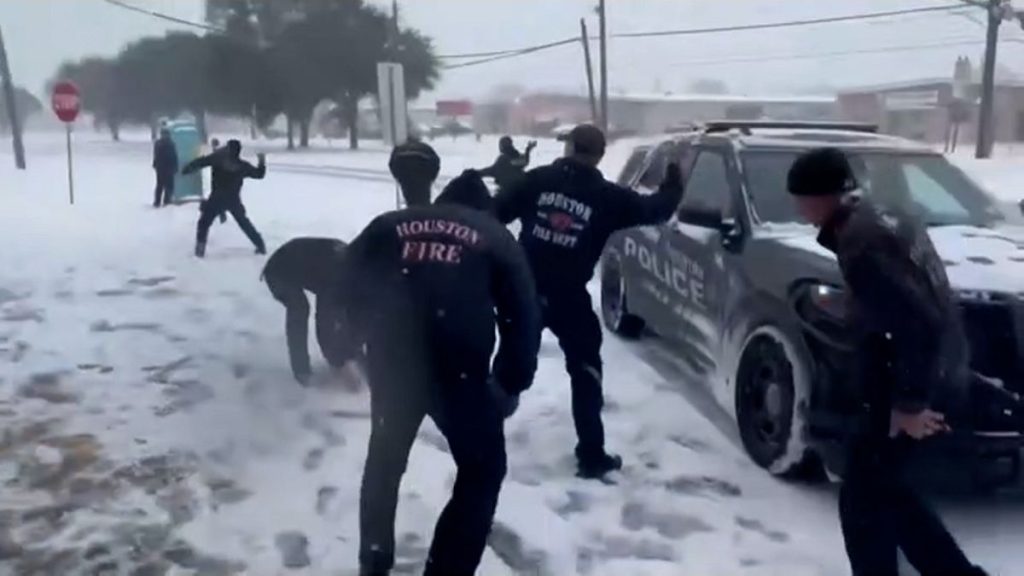A rare and powerful winter storm swept across the southern United States on Tuesday, bringing with it a blanket of snow and ice that transformed the typically warm landscapes of Texas, Louisiana, Alabama, and Florida into scenes reminiscent of a northern winter. The unexpected snowfall sparked a wave of excitement and wonder, particularly in regions unaccustomed to such wintry conditions. Social media platforms overflowed with images and videos capturing the unique moments, from the heartwarming spectacle of nuns engaging in a playful snowball fight in Metairie, Louisiana, to the jovial snow battles between firefighters and police officers in Houston. The unusual circumstances also spurred creative adaptations, with residents in Montgomery, Alabama, resorting to laundry baskets as makeshift sleds and adventurous souls in Houston taking advantage of snow-covered hills for impromptu tobogganing runs. These scenes of lightheartedness and community spirit offered a welcome respite from the broader disruption caused by the storm.
However, the heavy snowfall and freezing temperatures brought significant disruption and potential hazards to the affected regions. Major transportation networks ground to a halt, with motorway closures becoming widespread as road conditions deteriorated. The impact on education was substantial, with school closures affecting over a million students across the region. Air travel was also severely impacted, with nearly all flights in the affected areas grounded due to the hazardous conditions. The storm’s intensity was underscored by the unprecedented blizzard warnings issued for coastal counties in Texas and Louisiana, highlighting the rare nature of such a severe winter weather event in these typically mild climates. Iconic southern locales like Gulf Shores, Alabama, and Pensacola Beach, Florida, underwent a dramatic transformation, their familiar sandy beaches and palm trees replaced by a wintry blanket of snow, creating surreal and captivating scenes.
The heavy snow accumulation, with forecasts predicting up to 12 centimeters in New Orleans – the most in over a century – posed a significant threat to the region’s infrastructure and vegetation. Forecasters warned of the potential for widespread damage to delicate plants and crops, unable to withstand the prolonged freezing temperatures. The risk of burst pipes due to the freezing water within posed a serious concern for homeowners and businesses, potentially leading to water damage and disruption of essential services. Furthermore, the strain on power grids due to increased heating demands raised concerns about potential power outages, further exacerbating the challenges faced by residents in the affected areas. The widespread disruption and potential for infrastructure damage highlighted the vulnerability of southern states to such extreme weather events, which are typically less prepared for winter storms compared to their northern counterparts.
The storm’s impact rippled across the United States, extending far beyond the southern states directly affected by the snow and ice. The widespread disruption to air travel resulted in the cancellation of nearly 2,000 flights nationwide, with an additional 10,000 flights experiencing delays. This cascading effect underscored the interconnectedness of the national transportation system and the far-reaching consequences of severe weather events, even for those outside the immediate impact zone. The widespread cancellations and delays left travelers stranded and disrupted holiday plans for many, highlighting the broader economic and social ramifications of such weather events.
The rare winter storm that blanketed the southern United States served as a stark reminder of the unpredictable nature of weather patterns and the potential for extreme events to occur even in regions typically unaccustomed to such conditions. While the snowfall brought moments of joy and wonder, capturing the imagination of residents and prompting displays of community spirit, it also underscored the vulnerability of these regions to the disruptive and potentially damaging effects of severe winter weather. The widespread transportation disruptions, school closures, and potential for infrastructure damage highlighted the need for increased preparedness and resilience in the face of such events, even in traditionally warmer climates.
The contrasting images emerging from the affected regions – the playful snowball fights juxtaposed with the stranded travelers and the potential for infrastructure damage – painted a complex picture of the storm’s impact. While the rare snowfall provided a unique and memorable experience for many, it also served as a crucial reminder of the importance of preparedness and the potential consequences of underestimating the power of nature, even in regions where such extreme weather events are relatively infrequent. The storm’s aftermath will likely prompt a reassessment of infrastructure vulnerabilities and emergency preparedness strategies in the southern states, highlighting the need for greater resilience in the face of increasingly unpredictable weather patterns.














